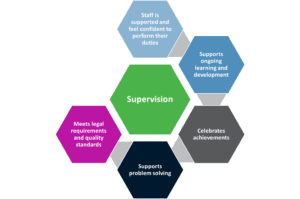Investing in supervision: good for your people and your organisation
Written by Lauranne Beernaert, Sector Support Coordinator
Our aged care workforce is everything. Without our staff, we cannot deliver any service or create meaningful relationships with clients. Our previous articles have all focused on workforce at the organisational level – through Workforce Planning or our Employee value proposition. This article will take a more operational approach and concentrate on a topic that seems to have less focus but is an important aspect of our workforce – staff supervision.
What is supervision and why is it important?
We tend to think about supervision as an activity that needs to be done to assess the performance of a person. It is often measured in KPIs, and the aim of the session is to find ways to increase productivity.
Supervision, however, is and should be more than that. It is a process when a manager meets regularly with another person to review/discuss their work. It requires reflection on practice, identification of areas for improvement and solutions, and establishment of development plans or strategies. Ultimately, it is intended to safeguard the quality of care delivered, by creating a capable and experienced worker.
This practical guide highlights 5 reasons why it is important:

This video explains why supervision is about checking in, not checking up on staff, and the difference it makes on care quality, effectiveness, and accountability.
You can also watch this 15 minute video that provides two practical examples of how supervision can be implemented in an aged care context and how it benefits both staff and consumers.
Additional benefits
- It helps you to look after staff wellbeing and be proactive about the risks of burnout.
- Supervision is associated with staff retention in human services (Chenoweth, Jeon, Merlyn, & Brodaty, 2009; Radford, Shacklock, & Bradley, 2013). Note that supervision, mentoring and coaching is all part of your employee value proposition.
- Can create conversations and reflections about human rights and their application. With the new Support at Home program and the introduction of a new Aged Care Act in 2023, conversations about what a rights-based approach in aged care means need to start now. Check this ‘Human Rights in Practice’ Training Card that we have developed.
For Top Tips for new and existing supervisors and the role and attributes of a good supervisor, check pages 14-22 of this guide.
Further, this Guide to Supervision provides an organisational self-assessment questionnaire to assess your organisation’s level of competence in relation to supervision (page 6). Other tools and templates can be found at the end of the document as well.
Different models
When it comes to supervision, there is no one-size-fits all model. Most of us might benefit from different types of supervision (e.g., quarterly group supervision, and monthly individual supervision). Therefore, the below examples do not prescribe one way to supervise a worker, rather aims at suggesting different ways of doing and their benefits so that you can integrate them into your organisation.
1. The line manager
| Characteristics | Advantages | Disadvantages |
|
|
|
2. External supervisor
| Characteristics | Advantages | Disadvantages |
|
|
|
3. Peer to Peer
| Characteristics | Advantages | Disadvantages |
|
|
|
4. Discipline Specific Group/Community of Practice
| Characteristics | Advantages | Disadvantages |
|
|
|
5. Mentoring
| Characteristics | Advantages | Disadvantages |
|
|
|
Check this resource that explores the role and benefits of a mentor.
6. Rosterer
| Characteristics | Advantages | Disadvantages |
|
|
|
Reflections
- Supervision is one way to show your staff that they matter. Make sure to incorporate it in your workplace (in any format that suits you and the staff member) on a regular basis, regardless of how long they have been in the role.
- A good supervisor can truly make a difference, but they need to have the right values, attributes, skills and knowledge for the role.
- Supervision templates or checklists can serve as a guide to deliver supervision, but do not have to be followed strictly. They help setting shared expectations, a clear purpose to the session and help the supervisee to prepare for each session.
- Supervision starts a conversation that can lead to delivering better care, provide earlier intervention when there are risks as well as provide emotional, psychological, and physical support to your workforce, leading to greater employee retention, lower recruitment costs, and skilled workforce.
References
Chenoweth, L., Jeon, YH., Merlyn, T., & Brodaty, H. (2009). A systematic review of what factors attract and retain nurses in aged and dementia care. Journal of Clinical Nursing, 19(1-2), 156-167. doi: 10.1111/j.1365-2702.2009.02955.x.
Radford, K., Shacklock, K., & Bradley, G. (2013). Personal care workers in Australian aged care: retention and turnover intentions. Journal of Nursing Management, 23(5), 557-566. doi:10.1111/jonm.12172.
Skills for Care. (2020). Effective supervision A practical guide for adult social care managers and supervisors. Retrieved from https://www.skillsforcare.org.uk/Documents/Learning-and-development/Effective-supervision/Effective-supervision-guide-ONLINE.pdf.
Volunteering and Contact ACT. (2019). Guide to supervision. Retrieved from https://www.volunteeringact.org.au/wp-content/uploads/2019/08/Guide-to-Supervision.pdf.